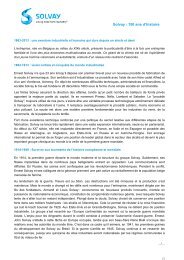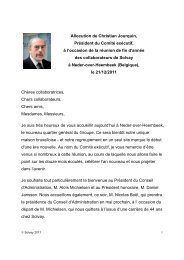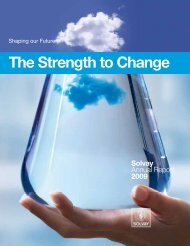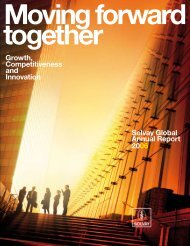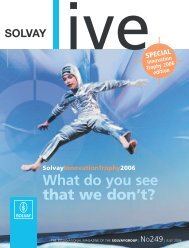Pharmaceuticals Sector - Solvay
Pharmaceuticals Sector - Solvay
Pharmaceuticals Sector - Solvay
Create successful ePaper yourself
Turn your PDF publications into a flip-book with our unique Google optimized e-Paper software.
62<br />
<strong>Solvay</strong> Global Annual Report 2005<br />
5. Retirement benefi t costs<br />
The Group operates a number of defi ned benefi t and<br />
defi ned contribution retirement benefi t plans. Payments<br />
to defi ned contribution retirement benefi t plans are<br />
charged as an expense as they fall due.<br />
The Group’s commitments under defi ned benefi ts<br />
plans, and the related costs, are valued using the<br />
“projected unit credit method” in order to determine<br />
the present value of the obligation at closing date.<br />
The amount recorded in the balance sheet represents<br />
the present value of the defi ned benefi t obligations,<br />
adjusted for actuarial differences, for unrecognized<br />
past services costs and for the fair value of external<br />
plan assets, limited in the case of a surplus to the<br />
present value of available refunds and/or reductions in<br />
future contributions.<br />
Actuarial differences exceeding the higher of 10% of<br />
the present value of the retirement benefi t obligations<br />
and 10% of the fair value of the assets of the<br />
external plan assets at balance sheet closing date<br />
are amortized over the expected average remaining<br />
working life of the participating employees.<br />
6. Income taxes<br />
Income taxes on profi ts for the period include both<br />
current and deferred taxes. They are recorded in the<br />
income statement except where they relate to items<br />
recorded directly in equity, in which case they too are<br />
recorded in equity.<br />
Current taxes are taxes payable on the taxable profi t<br />
for the period, calculated at the tax rates prevailing at<br />
the balance sheet closing date, as well as adjustments<br />
relating to previous periods.<br />
Deferred tax assets and liabilities are required to be<br />
measured at the tax rates that are expected to apply<br />
to the fi nancial year in which the asset is realized or the<br />
liability is settled, based on tax rates (and tax laws) that<br />
have been enacted or substantively enacted by the<br />
balance sheet date.<br />
Deferred tax liabilities relating to subsidiaries’ profi ts<br />
that the Group does not intend distributing in the<br />
foreseeable future are not accounted for.<br />
Deferred tax assets are recognized only where taxable<br />
profi ts are likely to be realized, against which the<br />
deferred tax assets will be imputed.<br />
7. Tangible and intangible assets<br />
Tangible and intangible assets are carried at their<br />
historical cost less depreciation/amortization.<br />
Depreciation/amortization is included in the income<br />
statement under cost of goods sold, commercial and<br />
administrative costs, and in R&D costs.<br />
Depreciation/amortization is calculated on a straightline<br />
basis, according to the useful life listed below:<br />
Buildings 30 years<br />
IT equipment 3 - 5 years<br />
Machinery and equipment 10 - 20 years<br />
Transportation equipment 5 - 20 years<br />
Patents and trademarks 5 - 20 years<br />
Assets held under fi nance leases are initially recognized<br />
as assets at the lower of their fair value or the present<br />
value of the minimum lease payments related to the<br />
contracts. The corresponding liability is included<br />
in fi nancial debts. Financial charges, representing<br />
the difference between the full amount of the lease<br />
obligations and the fair value of the assets acquired,<br />
are charged to the income statement over the duration<br />
of the contract.<br />
Borrowing costs directly attributable to the acquisition,<br />
construction or production of an asset requiring a long<br />
preparation period are added to the cost of this asset<br />
until it is ready for use.<br />
Grants for the purchase of assets are recorded net of<br />
the value of these assets.<br />
8. Research and Development costs<br />
Research costs are charged in the period in which they<br />
are incurred.<br />
Development costs are capitalized if, and only if all the<br />
following conditions are fulfi lled:<br />
- the product or process is clearly defi ned and the<br />
related costs are measured reliably and can be<br />
separately identifi ed;<br />
- the technical feasibility of the product has been<br />
demonstrated;<br />
- the product or process will be placed on the market<br />
or used internally;<br />
- the assets will generate future economic benefi ts (a<br />
potential market exists for the product or, where it is<br />
to be used internally, its future utility is demonstrated);<br />
- the technical, fi nancial and other resources required<br />
to complete the project are available.<br />
The capitalized development costs are amortized on<br />
a straight-line basis over their useful lives.<br />
- the technical, fi nancial and other resources required<br />
to complete the project are available.<br />
The capitalized development costs are amortized on a<br />
straight-line basis over their useful lives.


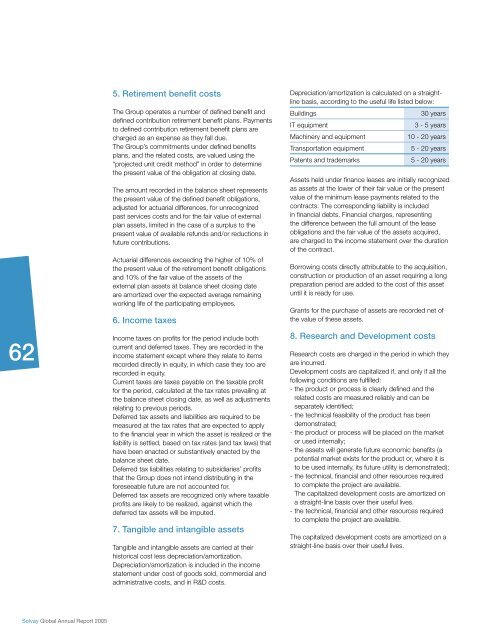

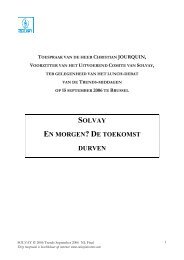
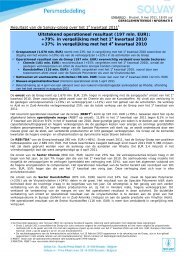

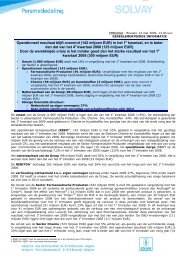
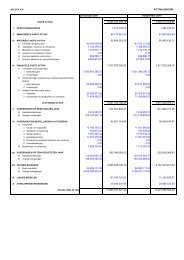

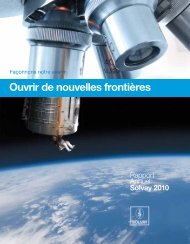
![PROC.1 [LETTRE] - Solvay](https://img.yumpu.com/16585746/1/184x260/proc1-lettre-solvay.jpg?quality=85)
